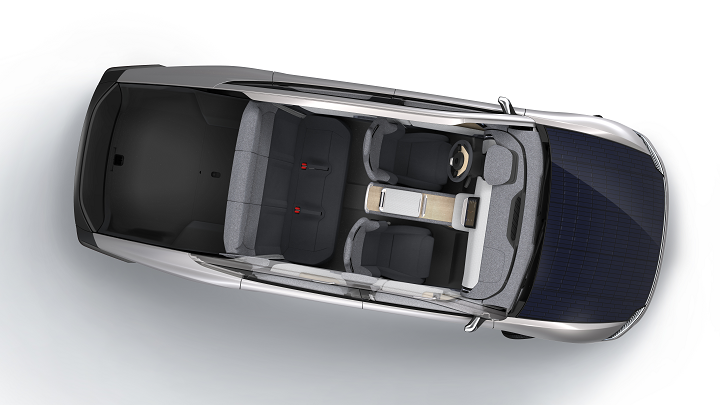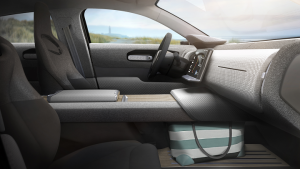 Dutch company DiManEx uses a network of AM partners to embed 3D printing in industrial supply chains, and has just announced that its latest collaborator is Lightyear, a company also based in the Netherlands that is producing the first long-range car powered by solar energy. Aptly called the Lightyear One, the 5-passenger sustainable car prototype was recently unveiled to the public and features over 60 3D printed interior parts, thanks to DiManEx’s digital supply platform.
Dutch company DiManEx uses a network of AM partners to embed 3D printing in industrial supply chains, and has just announced that its latest collaborator is Lightyear, a company also based in the Netherlands that is producing the first long-range car powered by solar energy. Aptly called the Lightyear One, the 5-passenger sustainable car prototype was recently unveiled to the public and features over 60 3D printed interior parts, thanks to DiManEx’s digital supply platform.
Lightyear’s live stream unveiling event of the prototype vehicle starts at around 33:33 in the video below:
“Did you know that all the cars in the world combined drive about nine and a half trillion kilometers per year – and most of them are combustion cars. And to change that is a challenge so immense that it’s almost frightening,” Lightyear’s CEO and co-founder Lex Hoefsloot said in the video. “Despite that, we started putting small steps forward, and in 2012 built the first four-seater solar car. And we’ve been in competitions, and through ups and downs our confidence had grown that we might be able to actually do something about this huge problem. So that’s why in 2016 we sat down to design a company from scratch – a company that would get to large impact in 10 to 15 years.”
 In an effort to make clean mobility available to everyone in the world, no matter where they are, the award-winning company has raised more than 20 million euros from grants, reservations, and investments over the last two years, including recent funding from the European Union’s Horizon 2020 program. Lightyear uses energy-efficient design and integrated solar cells to create electric cars that can, depending on the climate, travel up to 20,000 km a year.
In an effort to make clean mobility available to everyone in the world, no matter where they are, the award-winning company has raised more than 20 million euros from grants, reservations, and investments over the last two years, including recent funding from the European Union’s Horizon 2020 program. Lightyear uses energy-efficient design and integrated solar cells to create electric cars that can, depending on the climate, travel up to 20,000 km a year.
According to Hoefsloot, Lightyear is “applying an efficiency mindset to mobility.”
One of Lightyear’s founding principles is efficiency, and so the fast-growing company has been searching for partners with a similar mindset to help in the creation of a high-speed, high-quality prototype vehicle. Lightyear met DiManEx this March, and by June had already used its digital supply platform to get dozens of interior 3D printed parts ahead of the launch.
“Additive Manufacturing allows you to do a lot of iterations and get parts fast. We are able to transform the supply chain for companies like Lightyear. We provide what they need much faster without minimum order quantities and allowing for last minute changes on the fly,” explained DiManEx COO Henk Jonker about the company’s cloud-based, end-to-end supply platform. “There is no investment in tooling or tied up working capital required. It’s a no hassle solution that results in less waste, which is completely in line with the philosophy of both our companies. We are very proud of the speed at which we delivered parts for the Lightyear team and are thrilled to see each component come together to form a magnificent car, the first of its kind. It’s been a great cooperation with excellent results.”
The DiManEx digital supply platform for distributed 3D manufacturing can be accessed from anywhere in the world with just the click of a button, making it a great solution for manufacturers and parts intensive companies, like Lightyear, that are looking to 3D print small series and industrial parts.
Lightyear designed the over 60 3D printable parts for the Lightyear One prototype, while DiManEx created them through its network of AM partners. Because the two companies are both in the same country, the 3D printed interior car parts could be supplied within just 4-10 days, depending on how complex the part was and how much post-processing work was needed.
Several of the parts ended up needing changes; they were prototypes, after all. But as we’ve seen before, 3D printing is an ideal technology when it comes to making changes to prototype parts, and incorporating them for less money as well.
With one production facility in Helmond, Lightyear plans to open a new office this summer. Its Lightyear One model will enter production in 2020.
Discuss this and other 3D printing topics at 3DPrintBoard.com or share your thoughts below.
[Source/Images: DiManEx]Subscribe to Our Email Newsletter
Stay up-to-date on all the latest news from the 3D printing industry and receive information and offers from third party vendors.
Print Services
Upload your 3D Models and get them printed quickly and efficiently.
You May Also Like
Reinventing Reindustrialization: Why NAVWAR Project Manager Spencer Koroly Invented a Made-in-America 3D Printer
It has become virtually impossible to regularly follow additive manufacturing (AM) industry news and not stumble across the term “defense industrial base” (DIB), a concept encompassing all the many diverse...
Inside The Barnes Global Advisors’ Vision for a Stronger AM Ecosystem
As additive manufacturing (AM) continues to revolutionize the industrial landscape, Pittsburgh-based consultancy The Barnes Global Advisors (TBGA) is helping shape what that future looks like. As the largest independent AM...
Ruggedized: How USMC Innovation Officer Matt Pine Navigates 3D Printing in the Military
Disclaimer: Matt Pine’s views are not the views of the Department of Defense nor the U.S. Marine Corps Throughout this decade thus far, the military’s adoption of additive manufacturing (AM)...
U.S. Congress Calls Out 3D Printing in Proposal for Commercial Reserve Manufacturing Network
Last week, the U.S. House of Representatives’ Appropriations Committee moved the FY 2026 defense bill forward to the House floor. Included in the legislation is a $131 million proposal for...





































